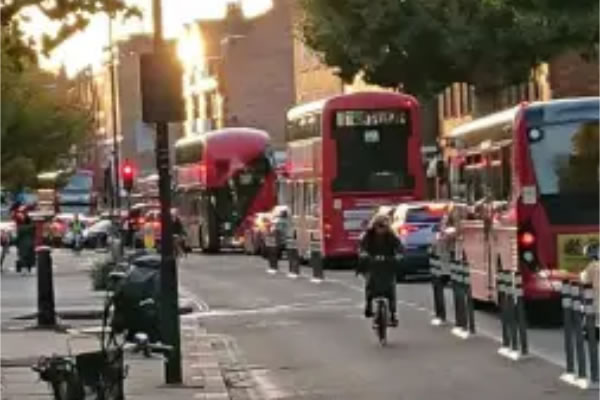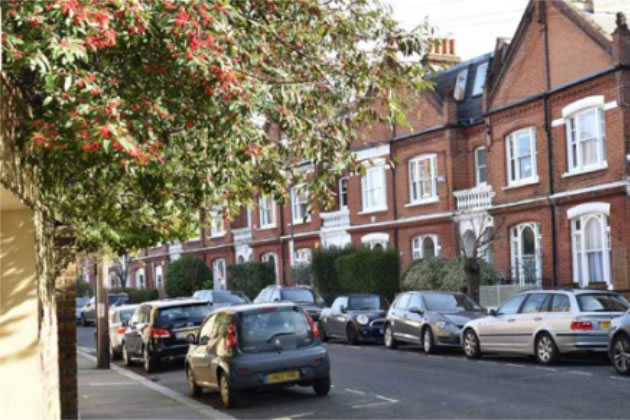Describes the policy as potentially discriminatory

Congestion on King Street this October. Picture: Hammersmith Society
December 30, 2022
The Hammersmith Society has issued a report on the council’s Clean Air Neighbourhoods programme in which it suggests the policy is potentially discriminatory and may even make air quality worse in the borough.
The document, which was published on the Society’s web site earlier this month, says that there are some good things about the programme including planting more street trees, improvements to street safety, and some incentives intended to reduce car use.
However, it is claimed that the policy will do little to improve air quality and, by concentrating pollution in certain areas, may lead to worse health outcomes.
The Society suggests that the council is simply rebranding Low Traffic Neighbourhood (LTN) schemes but using scare tactics on air quality to justify them. Its report states, “Welcome to the infamous Low Traffic Neighbourhood (LTN) debate that dare not speak its name – our council knows how toxic that is. Instead it has decided to use a heavy-handed mix of Fear, Uncertainty and Doubt, deployed with highly inflammatory headline-grabbing phrases such as TOXIC, SILENT KILLER, DEATH, in a decades-old ‘big stick’ approach. The claim of 40,000 UK annual deaths is a misappropriation of the data, which actually relates to life expectancy.”
In addition, the Society points out that, by not exempting electric vehicles from the restrictions, the council’s claim to be promoting a clean air policy is just a marketing ploy.
The council used figures on Nitrogen Dioxide in the borough in which in compared 2020 to 2021 which showed that the level was increasing slightly but this is distorted by lockdown. A comparison of 2021 to 2019 shows a 40% fall with lower emission buses and delivery vehicles being credited with much of the reduction. However, many of the buses running on King Street remain diesel powered and are increasingly being held up in traffic. Overall, the Society points to figures which suggests a continued and significant reduction in emissions from road transport which it says contradicts the council’s claims of a growing public health crisis.
Along with a proposal for a bridge toll, it accuses the council of creating ‘Fortress Hammersmith’ and raising the risk that neighbouring boroughs will erect similar barriers to non-residents entering their area.
The dispute about the impact of the controversial South Fulham Traffic, Congestion & Pollution Reduction (TCPR) scheme is continued with the Society claiming that traffic is worse overall with more congestion on main and boundary roads including the A4. It says that Department for Transport figures show that total vehicle miles driven have risen more quickly in boroughs which have introduced LTNs. Supporters of these schemes say that the data available is insufficient to reach such a conclusion.

Council says South Fulham scheme has reduced traffic in residential areas
The Society says that the displacement of traffic to the western side of Wandsworth Bridge Road required the extension of the existing South Fulham scheme but that the problem has now just shifted to another area with increased congestion on New Kings Road and in Wandsworth.
It also says that concentrating traffic in some areas raises issues of social justice. The report states, “ Kings College information shows that our backstreets are already as much as 50% less polluted than main roads. Clean Air Neighbourhoods might therefore be seen as a divisive and discriminatory policy addressing the wrong target, by aiming to improve air quality in areas where it’s not a significant problem, and diverting traffic to main roads, where it would worsen the sometimes already sub-standard air quality, slowing the movement of public transport and other traffic, reinforcing last year’s similarly ill-conceived bus lane removals, and concentrating any pollution on those doing the right thing – using the bus, walking or cycling.”
The Society believes that the main problem for the borough’s air quality comes from particulates but only 12% of this is due to road transport and pollution from this source has fallen by 90% since 1996.
The report says, “If we wanted to achieve something useful here, we’d be looking at the causes of the 88% first. But Mayoral Dogma, not the data, sets a last-century agenda before catalytic converters, Euro IV, V and VI regulations and, particularly recently, widespread EV take-up. The rapid fall in NO2 levels began when catalytic converters were legislated in 1993, yet – thirty years later – our council is still using NO2 as its principal AQ measure.”
With limited electronic sampling points and little real time data available, it is suggested that the council is ‘flying blind’ when it comes to air quality and that separate analysis shows that particulate levels are presenting the greater problem,
The council continues to defend the importance of the measures in improving air quality. When the South Fulham scheme was launched, Cllr Sharon Holder, H&F Cabinet Member for Public Realm said, "The air on our streets needs to be cleaner. Polluted air makes people ill - especially children. It can be a killer. “So we’re pioneering a Clean Air Neighbourhood programme to do something about it.”
Dr Nicola Lang, H&F’s Director of Public Health, added, "Poor air quality is the largest environmental risk to public health in the UK. Long term exposure to man-made air pollution in the UK is estimated to cause between 28,000 to 36,000 deaths every year. That is equivalent to around 87 deaths in our borough."
"Air pollution can affect both children and adults. It can lead to a variety of health problems, including heart disease, lung cancer, brain damage and - for older people - the risk of developing dementia. This bold new programme is great news for H&F."
The Clean Air Neighbourhood zones are being implemented across the borough through a series of Experimental Traffic Orders which means that a full consultation does not need to be held prior to introduction. Rather the schemes will be put into effect and residents and businesses will be allowed to give feedback for a trial period that could be as long as 18 months. Officers will try to determine possible issues from residents’ associations in targeted areas prior to the launch of experimental schemes.
H&F residents and key “permitted vehicles”, such as buses, black cabs, emergency services, and waste vehicles, will be unaffected by the access restrictions and will be able to pass through the cameras and move around the area without incurring a penalty.
Like Reading Articles Like This? Help Us Produce More This site remains committed to providing local community news and public interest journalism. Articles such as the one above are integral to what we do. We aim to feature as much as possible on local societies, charities based in the area, fundraising efforts by residents, community-based initiatives and even helping people find missing pets. We’ve always done that and won’t be changing, in fact we’d like to do more. However, the readership that these stories generates is often below that needed to cover the cost of producing them. Our financial resources are limited and the local media environment is intensely competitive so there is a constraint on what we can do. We are therefore asking our readers to consider offering financial support to these efforts. Any money given will help support community and public interest news and the expansion of our coverage in this area. A suggested monthly payment is £8 but we would be grateful for any amount for instance if you think this site offers the equivalent value of a subscription to a daily printed newspaper you may wish to consider £20 per month. If neither of these amounts is suitable for you then contact info@neighbournet.com and we can set up an alternative. All payments are made through a secure web site. One-off donations are also appreciated. Choose The Amount You Wish To Contribute. If you do support us in this way we’d be interested to hear what kind of articles you would like to see more of on the site – send your suggestions to the editor. For businesses we offer the chance to be a corporate sponsor of community content on the site. For £30 plus VAT per month you will be the designated sponsor of at least one article a month with your logo appearing if supplied. If there is a specific community group or initiative you’d like to support we can make sure your sponsorship is featured on related content for a one off payment of £50 plus VAT. All payments are made through a secure web site. |